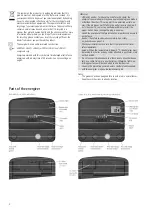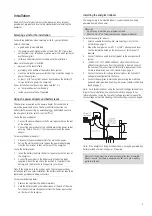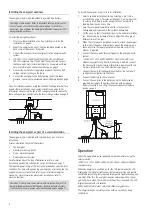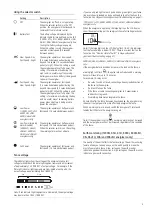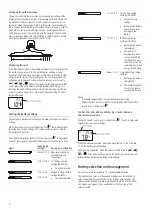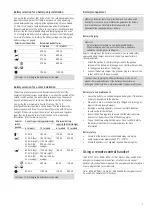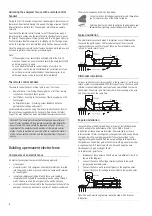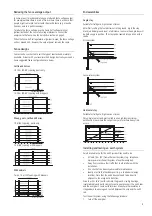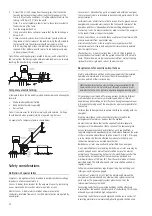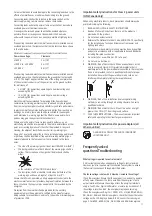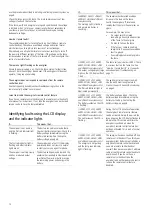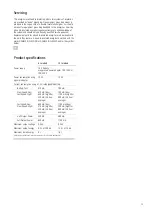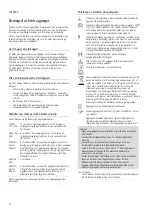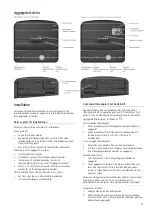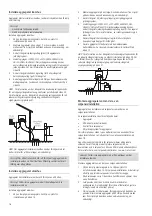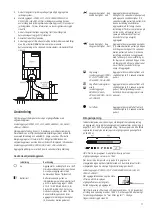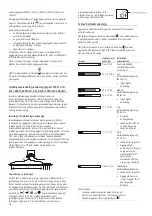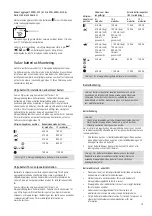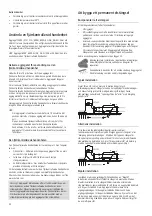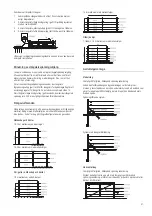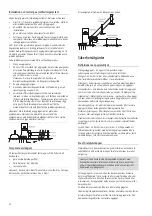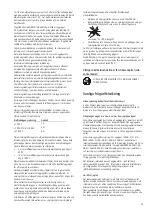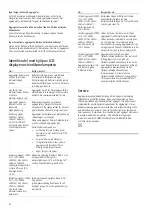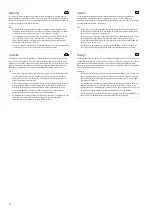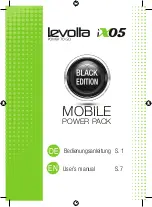
10
2
At least 100 m (330’) away from the energizer, short circuit the
fence by laying several steel rods or lengths of pipe against the
fence. In dry or sandy conditions, it may be necessary to drive the
rods up to 300 mm (12”) into the earth.
Note:
It is not acceptable to short-circuit a fence return system to
the earth wire of the fence.
3
Turn the energizer back on.
4
Using an electric fence voltmeter, ensure that the fence voltage is
below 2 kV.
5
Check your earth system.
Insert the voltmeter’s earth probe into
the ground at the full extent of the lead, and clip the other lead to
the last earth rod. The voltmeter should not read more than
0.8 kV. Anything higher than this indicates that better earthing is
required. Either add more earth rods or find a better ground area
to drive in the earth rods.
Note:
When earthing energizers located in dairies, earth at least 20 m
(65’) away from the dairy using double-insulated lead-out wire to avoid
touching the dairy building or equipment.
Temporary electric fencing
A temporary fence can be quickly erected and easily moved allowing the
farmer to:
•
Make smaller paddocks (fields)
•
Keep herds of animals separated
•
Ration feed
Note:
Use more wires for smaller animals and wild animals. Politape
should be used when greater visibility is required (e.g. horses).
An example of a temporary fence is shown below.
Safety considerations
Definition of special terms
Energizer
– An appliance that is intended to periodically deliver voltage
impulses to a fence connected to it.
Fence
– A barrier for animals or for the purpose of security, comprising
one or more conductors such as metal wires, rods or rails.
Electric fence
– A barrier which includes one or more electric
conductors, insulated from earth, to which electric pulses are applied by
an energizer.
Fence circuit
– All conductive parts or components within an energizer
that are connected or are intended to be connected, galvanically, to the
output terminals.
Earth electrode
– Metal structure that is driven into the ground near an
energizer and connected electrically to the Fence earth terminal of the
energizer, and that is independent of other earthing arrangements.
Connecting lead
– An electric conductor, used to connect the energizer
to the electric fence or the earth electrode.
Electric animal fence
– An electric fence used to contain animals within
or exclude animals from a particular area.
Electric security fence
– A fence used for security purposes which
comprises an electric fence and a physical barrier electrically isolated
from the electric fence.
Physical barrier
– A barrier not less than 1.5 m (5’) high intended to
prevent inadvertent contact with the pulsed conductors of the electric
fence. Physical barriers are typically constructed from vertical sheeting,
rigid vertical bars, rigid mesh, rods or chainwire mesh.
Requirements for electric animal fences
Electric animal fences and their ancillary equipment shall be installed,
operated and maintained in a manner that minimises danger to
persons, animals or their surroundings.
Warning!
Avoid contacting electric fence wires especially with the
head, neck or torso. Do not climb over, through or under a multi-
wire electric fence. Use a gate or a specially designed crossing point.
This energizer is not intended for use by persons (including children)
with reduced physical, sensory or mental capabilities, or lack of
experience and knowledge, unless they have been given supervision or
instruction concerning use of the energizer by a person responsible for
their safety.
Children should be supervised to ensure that they do not play with the
energizer.
Electric animal fence constructions that are likely to lead to the
entanglement of animals or persons shall be avoided.
An electric animal fence shall not be supplied from two separate
energizers or from independent fence circuits of the same energizer.
For any two separate electric animal fences, each supplied from a
separate energizer independently timed, the distance between the wires
of the two electric animal fences shall be at least 2.5 m (8’). If this gap
is to be closed, this shall be effected by means of electrically non-
conductive material or an isolated metal barrier.
Barbed wire or razor wire shall not be electrified by an energizer.
A non-electrified fence incorporating barbed wire or razor wire may be
used to support one or more off-set electrified wires of an electric
animal fence. The supporting devices for the electrified wires shall be
constructed so as to ensure that these wires are positioned at a
minimum distance of 150 mm (6”) from the vertical plane of the non-
electrified wires. The barbed wire and razor wire shall be earthed at
regular intervals.
Follow our recommendations regarding earthing. See
Installing and
testing an earth system
on page 9.
A distance of at least 10 m (33’) shall be maintained between the
energizer earth electrode and any other earthing system connected
parts such as the power supply system protective earth or the
telecommunication system earth.
Connecting leads that are run inside buildings shall be effectively
insulated from the earthed structural parts of the building. This may be
achieved by using insulated high voltage cable.
Connecting leads that are run underground shall be run in conduit of
insulating material or else insulated high voltage cable shall be used.


